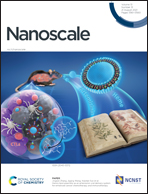Single-molecule mechanical study of an autonomous artificial translational molecular motor beyond bridge-burning design†
Abstract
A key capability of molecular motors is sustainable force generation by a single motor copy. Direct force characterization at the single-motor level is still missing for artificial molecular motors, though long reported for their biological counterparts. Here we report single-molecule detection of sustained force-generating motility for an artificial track-walking molecular motor capable of autonomous chemically fueled operation. A single motor plus its track (both made of deoxyribonucleic acids or DNA) is assembled, operated and detected under magnetic tweezers by a method designed to overcome difficulty from the motor's soft double-stranded track. The motor shows self-directed walking by ∼16 nm steps up to a distance of 120 nm (covering the entire track), yielding a stall force of ∼2–3 pN. These results imply a reasonably efficient chemomechanical conversion of the motor compared to a high-efficiency biomotor. The stall force is near the level of translational biomotors powering human muscles and allows similar force-demanding applications by their artificial counterparts. This single-motor study reveals fast subsecond steps, suggesting big room for improvement in the speed of DNA motors in general. Besides, the established single-molecule method is applicable to force measurements of many other DNA motors with soft tracks.



 Please wait while we load your content...
Please wait while we load your content...